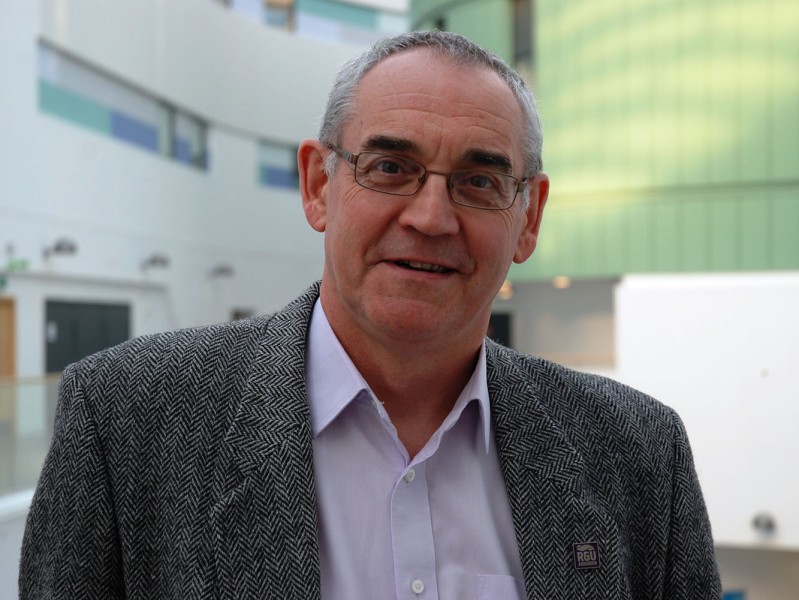A Drug Journey – From Bench to Bedside
Monday 22 October 2018

One of the most striking things that I have observed during my career – I have worked in four different UK Schools of Pharmacy, otherwise known as Pharmacy and Life Sciences at RGU – is the breadth of expertise that colleagues bring to a School of Pharmacy.
Unlike, say, departments of Chemistry, Biology or Medicine, which are highly specific to a narrow subject field, Pharmacy has breadth. It encapsulates many sub-disciplines and builds a bridge between the traditional sciences of chemistry, biology and physics with the clinical sciences.
A School of Pharmacy allows us to examine the entire journey of a drug quite literally ‘from bench to bedside’ and beyond. In many ways, the expertise that exists within the School mimics the activities of a small innovator pharmaceutical company and takes that experience onto the clinic.
Drug discovery is a process of innovation and creation fuelled by the desire to address an unmet medical need. It begins with the generation of ideas, identifying those of value through modern approaches such as computer-aided drug design. These ideas are then materialised with the synthesis of a new chemical entity (NCE), in a chemistry laboratory. Once synthesised, the NCE needs to be identified and fully characterised, and this requires the use of sophisticated analytical and spectroscopic techniques such as Infra-Red (IR), Nuclear Magnetic Resonance (NMR) spectroscopy, Mass Spectrometry (MS), or a combination of techniques.
Alternatively, the active substance may be a natural product produced by a plant, an animal or a micro-organism. In this case, the active compound must be isolated and extracted from a complex background of related chemicals (perhaps many thousand), identified and characterised. These techniques are all studied by students within the Chemistry labs in the School.
Once the NCE has been identified and the structure determined, the sample must be analysed to ascertain its purity and to determine whether there are any potentially hazardous impurities present. This is usually accomplished in our Analytical Chemistry laboratory, using separation techniques of gas or liquid chromatography.
Any compound used therapeutically must comply with the purity requirements of the British or European Pharmacopoeia. These publications provide legally binding standards on all pharmaceutical manufacturers. If a preparation complies with the requirements of the Pharmacopoeia, it is labelled with the letters ‘BP’ or ‘EP’ after its name.
In addition to the chemical identification of the drug, a sample must undergo pharmacological testing to ascertain whether it possesses any efficacy (or, more prosaically, to see if it works at all).
These analyses are undertaken in Pharmacology laboratories using a mixture of in vitro assays (i.e. studies carried out within a laboratory), or in vivo studies requiring the use of whole animals.
Substances administered to a body seldom remain unchanged and are usually modified into more water-soluble derivatives, called ‘metabolites,’ by enzymes in the body. This process must be studied to ensure these metabolites are not toxic or hazardous. Very often, the initial compound must be refined to produce a compound where any benefit outweighs the risk of undesirable side-effects.
At the end of this process, if everything has gone to plan, there will be a candidate compound which is active against the chosen disease state. This drug now needs to be formulated into a medicine.
The terms ‘drug’ and ‘medicine’ are often used synonymously but they are quite different.
A drug is the active chemical substance, whereas a medicine is the formulated product supplied to the patient. For example, aspirin is a drug, but aspirin tablets are a medicine. Hydrocortisone is a drug, but hydrocortisone ointment is a medicine and so on.
Great skill is required to produce a stable medicine with a sufficiently long shelf-life which is also palatable and easily taken – this is accomplished in Pharmaceutics labs. The drug paracetamol has an awful taste, but syrup preparations manage to disguise the unpleasant taste and allow the product to be taken by children.
The discovery and manufacture of drugs and medicines is only one aspect of the work of a School of Pharmacy and Life Sciences.
A huge amount of the work we do is concerned with ‘patient-facing’ aspects, or Clinical Pharmacy Practice. These describe the clinical interactions a pharmacist has with the patient to ensure that he or she is receiving the correct medicine, at the correct dose, for the correct condition. Pharmacists are the experts in medicines and should be involved in all aspects of therapeutics.
In the UK, Pharmacists may initiate drug therapy without recourse to a physician. This development of non-medical prescribing, recognises the pharmacist’s unique knowledge of medicines and their uses, and has revolutionised Pharmaceutical Care in recent years.
Pharmacists are also involved in pharmacovigilance, clinical trials and improving healthcare for the population, as a whole. Pharmaceutical Public Health allows the pharmacist to give advice on topics such as smoking cessation, alcohol reduction, emergency contraception, and much more. These policies and initiatives are often instigated by governments and seek to improve the health of the global population, rather than that of the individual.
The staff expertise and excellent facilities available within the School of Pharmacy and Life Sciences at RGU allow each step of the drug journey to be studied and demonstrated in a fully integrated manner from bench to bedside. If we do this well, we will inspire and educate the next generation of leaders in Pharmacy.
